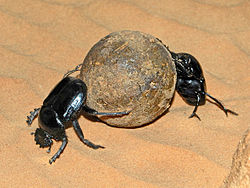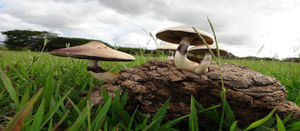Coprophagia: Difference between revisions
No edit summary |
No edit summary |
||
| Line 1: | Line 1: | ||
[[File:Millipede.jpg|175px|thumb|right|Some species of Diplopods are obligate coprophages.]] | [[File:Millipede.jpg|175px|thumb|right|Some species of Diplopods are obligate coprophages.]] | ||
== | == Definition == | ||
'''Coprophagia''' or '''Coprophagy''' are terms associated with the act of consuming feces. The word is derivative of the Greek κόπρος (copros), "feces" and φαγεῖν (phagein), "to eat". ''Coprophagy'' comes in many different flavors; ''heterospecifics'' consume the feces of other species, ''allocoprophagy'' is the consumption of the feces of an individual of the same species and ''autocoprophagy'' is the consumption of one's own feces. It is typical of some animal species to eat feces, lagomorphs do so to allow tough plant material to digest more efficiently via two passages through the digestive tract. Other species may eat feces under specific behavioral conditions that are beneficial to the species, its symbiont and the surrounding environment. | '''Coprophagia''' or '''Coprophagy''' are terms associated with the act of consuming feces. The word is derivative of the Greek κόπρος (copros), "feces" and φαγεῖν (phagein), "to eat". ''Coprophagy'' comes in many different flavors; ''heterospecifics'' consume the feces of other species, ''allocoprophagy'' is the consumption of the feces of an individual of the same species and ''autocoprophagy'' is the consumption of one's own feces. It is typical of some animal species to eat feces, lagomorphs do so to allow tough plant material to digest more efficiently via two passages through the digestive tract. Other species may eat feces under specific behavioral conditions that are beneficial to the species, its symbiont and the surrounding environment. Coprophagous organisms are geographically and morphologically diverse and consist of mega-, macro- and mesofauna. | ||
[[File:dungbeetle.jpg|thumb|left|Two ''Scarabaeus sacer'' individuals rolling a ball of dung]] | [[File:dungbeetle.jpg|thumb|left|Two ''Scarabaeus sacer'' individuals rolling a ball of dung]] | ||
Revision as of 10:58, 24 April 2019
Definition
Coprophagia or Coprophagy are terms associated with the act of consuming feces. The word is derivative of the Greek κόπρος (copros), "feces" and φαγεῖν (phagein), "to eat". Coprophagy comes in many different flavors; heterospecifics consume the feces of other species, allocoprophagy is the consumption of the feces of an individual of the same species and autocoprophagy is the consumption of one's own feces. It is typical of some animal species to eat feces, lagomorphs do so to allow tough plant material to digest more efficiently via two passages through the digestive tract. Other species may eat feces under specific behavioral conditions that are beneficial to the species, its symbiont and the surrounding environment. Coprophagous organisms are geographically and morphologically diverse and consist of mega-, macro- and mesofauna.

Invertebrates
Coprophagous insects, of the Hexapod group of the Arthropod phylum, consume and digest the feces of larger species that have digestive tracts of lesser efficiency when it comes to breaking down nutrients in foods and making them biologically available for further uptake by plants or animals. Some species of flies and Dung Beetles are known to be coprophagic, they feed on the microorganism-rich excrement of other species. Dung Beetles make balls of dung by rolling them, they then bury the balls underground and lay there eggs within it.
A common temporary resident in the soils of temperate deciduous forests, the Hawthorn fly is plays an important role in leaf litter decomposition and exploits the rich resources in the feces of other soil organisms as another source of food [1]. Some coprophagic earthworms' affinity for feces enriched soil make them important disseminators of some microbial pathogens such as T. gondii [2].

Coprophilous Fungi
Coprophilous Fungi such as species Cheilymenia are a type of saprobic ascomycete that feed and grow on the animal dung. The spores of this fungi are unwittingly consumed by animals from vegetation, then excreted with the plant matter. The fruiting bodies, or mushrooms, of these fungi can be seen on top of dung piles. What is most interesting is that there exist vast mycelial networks within the dung piles that allow for the succession of the fruiting bodies. Psilocybe, Panaeolus, and Coprinus species are also sometimes found growing out of dung and species [3].
Nutrient Cycling
Coprophagous organisms can help an ecosystem cycle nutrients by breaking down materials that are not yet biologically available to plants for uptake and use. Biological aging or scenescence is the gradual deterioration of the functional characteristics of organic material, it results in the loss of nutrients to the environment. Coprophagous soil arthropods such as the Porcelio scaber isopod can increase nutrient release from animal frass and leaf litter via multiple digestions of the organic material [4]. The activity and respiration of soil microbes has been shown to increase in the presence of coprophagous detritivores in experimental settings [4].
References
1. A. Špaldoňová, The role of soil microfauna in organic matter decomposition and stabilization, (Charles University in Prague: Faculty of Science, 2014), 3.3.
2. S. Bettiol, et al., Earthworms as Paratenic Hosts of Toxoplasmosis in Eastern Barred Bandicoots in Tasmania, (Journal of Wildlife Diseases, 2000), 147.
3. H. Lepp, Dung Fungi, (Information about Australia's Flora: Fungal ecology, 2013).
4. M. Madritch, et al., Canopy herbivory can mediate the influence of plant genotype on soil processes through frass deposition, (Soil Biology and Biochemistry, 2007).